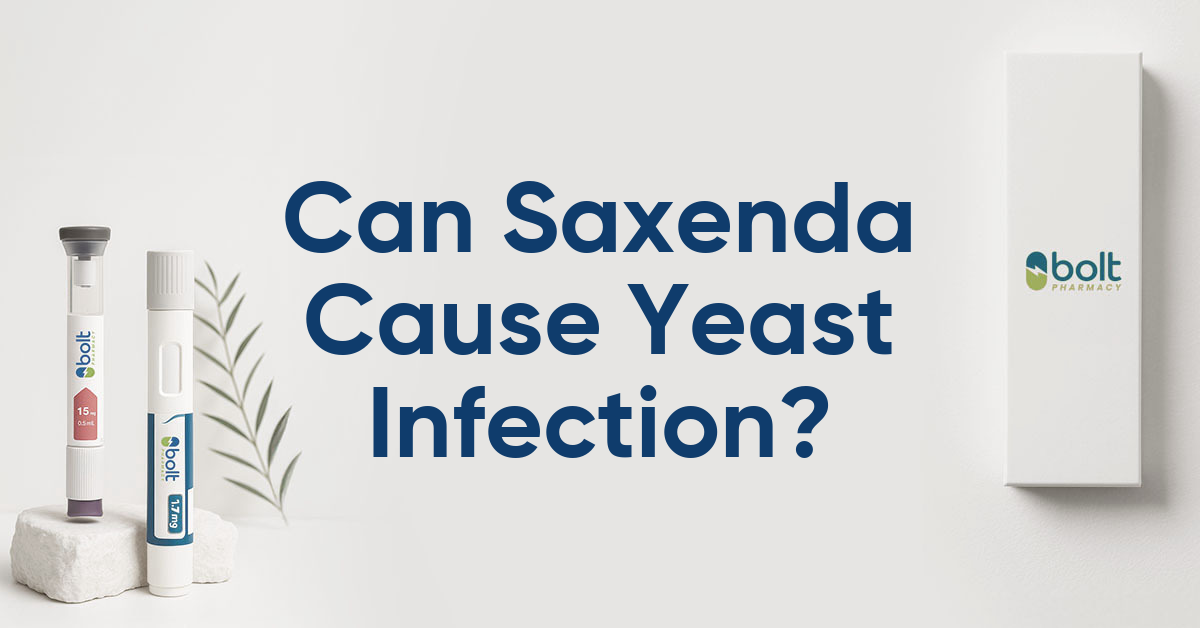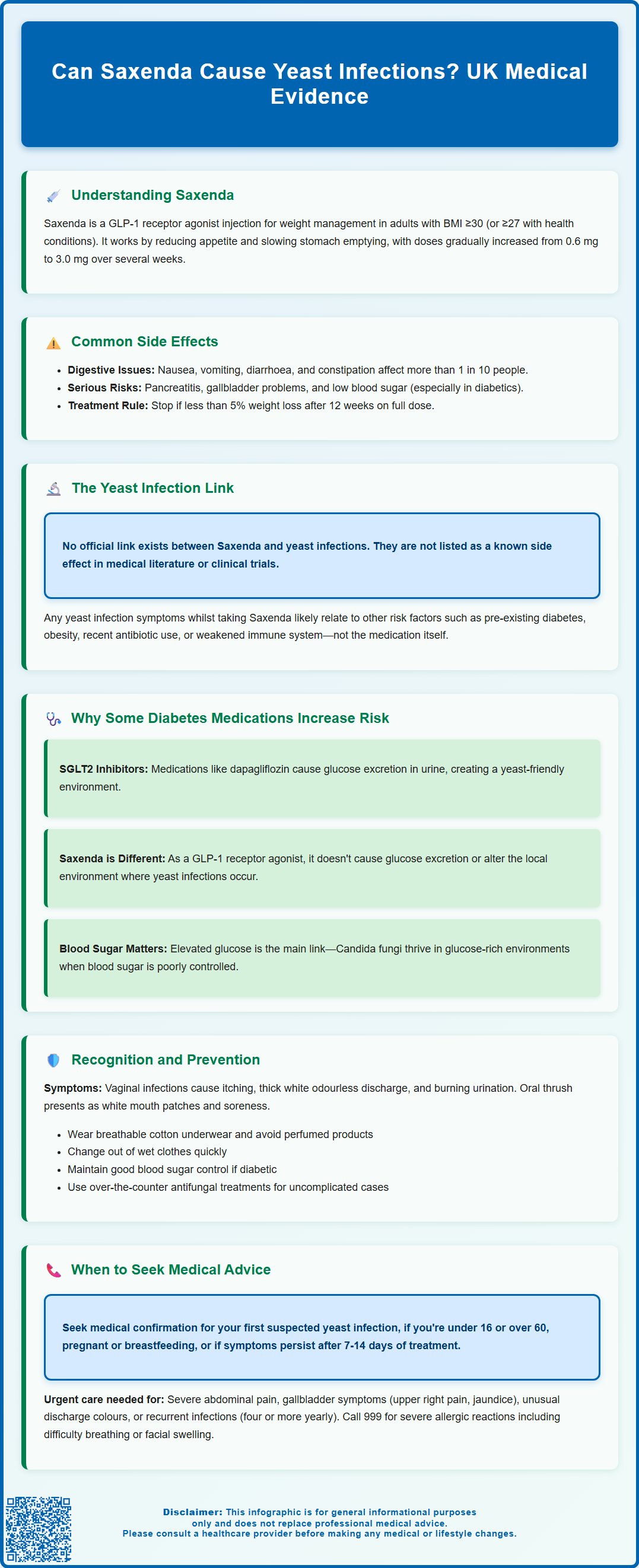Mounjaro®
Dual-agonist support that helps curb appetite, hunger, and cravings to drive substantial, sustained weight loss.
- ~22.5% average body weight loss
- Significant weight reduction
- Improves blood sugar levels
- Clinically proven weight loss

Saxenda (liraglutide 3.0 mg) is a GLP-1 receptor agonist licensed in the UK for weight management in adults and adolescents with obesity. Whilst the medication has a well-documented side effect profile—primarily gastrointestinal symptoms—many patients wonder whether Saxenda can cause yeast infections. Understanding the relationship between weight management medications and infection risk is important for informed treatment decisions. This article examines the evidence linking Saxenda to candidiasis, explores indirect risk factors, and provides guidance on recognising and managing yeast infections whilst taking this medication.
Summary: Saxenda is not directly linked to yeast infections, as candidiasis is not listed among its known side effects in UK regulatory guidance or clinical trials.
Saxenda (liraglutide 3.0 mg) is a prescription medication licensed in the UK for weight management in adults with obesity (BMI ≥30) or those who are overweight (BMI ≥27) with weight-related health conditions. It's also licensed for adolescents aged 12 to <18 years with obesity and body weight >60 kg. Saxenda belongs to a class of medicines called GLP-1 receptor agonists (glucagon-like peptide-1), which work by mimicking a naturally occurring hormone that regulates appetite and food intake.
The mechanism of action involves slowing gastric emptying, reducing appetite, and increasing feelings of fullness after eating. Saxenda is administered as a once-daily subcutaneous injection, typically in the abdomen, thigh, or upper arm. The dose is gradually increased over several weeks (0.6 mg weekly increments to a maximum of 3.0 mg daily) to minimise side effects and improve tolerability. Treatment should be discontinued if at least 5% weight loss has not been achieved after 12 weeks on the 3.0 mg daily dose.
Common side effects reported with Saxenda include:
Gastrointestinal symptoms: nausea, vomiting, diarrhoea, constipation, and abdominal pain (affecting more than 1 in 10 people)
Injection site reactions: redness, itching, or bruising at the injection site
Headache and dizziness
Fatigue and weakness
Hypoglycaemia: particularly in people with type 2 diabetes taking sulfonylureas or insulin
Most gastrointestinal side effects tend to improve over time as the body adjusts to the medication. According to the Saxenda Summary of Product Characteristics (SmPC), serious side effects include pancreatitis and gallbladder problems (cholelithiasis is common and associated with weight loss). Thyroid tumours have been observed in animal studies. Patients should be counselled about these risks before starting treatment.
Whilst Saxenda is generally well-tolerated when used appropriately, understanding its side effect profile helps patients distinguish between expected reactions and symptoms that may require medical attention. This knowledge is particularly important when considering whether new symptoms, such as infections, might be related to the medication.
If you experience any side effects, talk to your doctor, pharmacist or nurse. This includes any possible side effects not listed in the package leaflet. You can also report side effects directly via the Yellow Card Scheme at yellowcard.mhra.gov.uk.

There is no official, direct link established between Saxenda and an increased risk of yeast infections (candidiasis) in the current medical literature or regulatory guidance. Yeast infections are not listed among the known side effects in the Saxenda Summary of Product Characteristics (SmPC), and clinical trials have not identified a specific association between liraglutide and fungal infections.
However, it is important to understand the indirect factors that may contribute to infection risk in individuals taking Saxenda. The medication is primarily prescribed for weight management, and many patients using Saxenda may have additional risk factors for yeast infections, including:
Pre-existing or undiagnosed type 2 diabetes: Many Saxenda users have metabolic syndrome or impaired glucose tolerance
Obesity: Excess weight creates skin folds where moisture and warmth promote fungal growth
Recent antibiotic use: Can disrupt normal bacterial balance
Immunosuppressive conditions or treatments: May increase susceptibility to infections
Pregnancy: Associated with higher risk of vaginal candidiasis
It's worth noting that liraglutide at lower doses (1.2 mg or 1.8 mg, marketed as Victoza) is licensed for type 2 diabetes management. Whilst diabetes itself significantly increases yeast infection risk due to elevated blood glucose levels, this is related to the underlying condition rather than the medication.
If you develop symptoms of a yeast infection whilst taking Saxenda, it is more likely related to other risk factors rather than the medication itself. Nevertheless, any new or persistent symptoms should be discussed with your GP or healthcare provider to ensure appropriate investigation and management.
Understanding why certain diabetes medications may be associated with increased infection risk helps clarify the relationship between metabolic treatments and fungal infections. Whilst Saxenda is primarily a weight management medication, its mechanism and patient population overlap significantly with diabetes care.
Elevated blood glucose is the primary factor linking diabetes to yeast infections. Candida species (the fungi responsible for most yeast infections) thrive in glucose-rich environments. When blood sugar levels are poorly controlled, glucose appears in bodily fluids including urine, vaginal secretions, and sweat, creating ideal conditions for fungal overgrowth. This is why uncontrolled diabetes is one of the strongest risk factors for recurrent candidiasis.
Certain diabetes medications, particularly SGLT2 inhibitors (such as dapagliflozin, empagliflozin, and canagliflozin), have a well-established association with genital fungal infections. These medications work by causing the kidneys to excrete excess glucose through urine, which directly increases glucose concentration in the genital area. The MHRA has issued specific guidance about this risk, and genital mycotic infections are listed as common to very common side effects (frequency varies by product and sex) for this drug class.
GLP-1 receptor agonists like Saxenda, by contrast, work through entirely different mechanisms:
They do not cause glucose excretion in urine
They help improve glycaemic control (when used for diabetes)
They do not directly alter the local environment where yeast infections typically occur
The key distinction is that whilst diabetes itself increases infection risk, not all diabetes or weight management medications carry the same risk profile. Saxenda's mechanism of action does not include the glucose-related pathways that would promote fungal growth.
Yeast infections can occur in various parts of the body, with vaginal candidiasis and oral thrush being most common. Recognising symptoms early enables prompt treatment and prevents complications.
Vaginal yeast infection symptoms include:
Itching, irritation, or soreness in the vaginal area
Thick, white, cottage cheese-like discharge (usually odourless)
Pain or discomfort during intercourse
Burning sensation when urinating
Redness and swelling of the vulva
Oral thrush symptoms include:
White patches on the tongue, inner cheeks, or throat
Redness or soreness in the mouth
Difficulty swallowing
Loss of taste or unpleasant taste
Cracking at the corners of the mouth
Management approaches for yeast infections whilst taking Saxenda should follow standard NHS guidance:
For uncomplicated vaginal thrush: Over-the-counter antifungal treatments (clotrimazole pessaries or cream) are usually effective. Oral fluconazole capsules are also available from pharmacies for those aged 16-60 who are not pregnant or breastfeeding. Pharmacists can provide advice on appropriate treatment.
For oral thrush: Miconazole oral gel or nystatin suspension are typically used. These require a prescription from your GP or dentist. Note that miconazole oral gel can interact with warfarin and other medications, so always check with your pharmacist or doctor before using it.
Preventive measures include:
Wearing loose-fitting, breathable cotton underwear
Avoiding perfumed soaps, bubble baths, and vaginal douches
Changing out of wet clothing (swimwear, gym clothes) promptly
Maintaining good blood glucose control if you have diabetes
Ensuring adequate hydration
Practising good hygiene without over-washing
Avoiding unnecessary antibiotics when possible
Continue taking Saxenda as prescribed unless specifically advised otherwise by your healthcare provider. There is no need to stop the medication due to a yeast infection, as treatment can typically be managed alongside your weight management programme. If infections become recurrent (four or more episodes per year), further investigation may be needed to identify underlying causes.
Whilst many yeast infections can be managed with over-the-counter treatments, certain situations require professional medical assessment. Contact your GP or healthcare provider if:
Regarding yeast infections:
This is your first suspected yeast infection – diagnosis should be confirmed by a healthcare professional
You are under 16 or over 60 years old
You are pregnant or breastfeeding
Symptoms do not improve after 7–14 days of over-the-counter treatment
You experience recurrent infections (four or more in 12 months)
You develop unusual symptoms such as fever, abdominal pain, or foul-smelling discharge (which may indicate a different infection)
The discharge is yellow, green, or blood-stained
You have sores, blisters, or ulcers in the genital area
Regarding Saxenda treatment:
You experience severe or persistent abdominal pain – stop taking Saxenda and seek urgent medical care (potential sign of pancreatitis)
You develop symptoms of gallbladder problems: pain in the right upper abdomen, fever, jaundice (yellowing of skin/eyes), pale stools or dark urine
You develop symptoms of thyroid problems: lump in the neck, hoarseness, difficulty swallowing
You have signs of severe allergic reaction: difficulty breathing, swelling of face or throat, rapid heartbeat – call 999 immediately
You experience severe hypoglycaemia (if taking other diabetes medications)
You notice signs of dehydration from persistent vomiting or diarrhoea
Your GP can perform appropriate investigations, including vaginal swabs if needed, to confirm the diagnosis and rule out other conditions such as bacterial vaginosis or sexually transmitted infections. They can also review your overall medication regimen and assess whether any adjustments are needed.
Patients on weight management medications should have regular follow-up appointments with their prescriber or specialist weight management service to monitor progress, side effects, and overall health. Use these appointments to discuss any concerns, including recurrent infections, to ensure comprehensive care throughout your treatment journey.
No, yeast infections are not listed as a known side effect in the Saxenda Summary of Product Characteristics, and clinical trials have not identified a specific association between liraglutide and fungal infections.
No, continue taking Saxenda as prescribed unless specifically advised otherwise by your healthcare provider. Yeast infections can typically be managed with over-the-counter or prescription antifungal treatments alongside your weight management programme.
Contact your GP if this is your first suspected yeast infection, symptoms do not improve after 7–14 days of treatment, you experience recurrent infections (four or more in 12 months), or you develop unusual symptoms such as fever or foul-smelling discharge.
The health-related content published on this site is based on credible scientific sources and is periodically reviewed to ensure accuracy and relevance. Although we aim to reflect the most current medical knowledge, the material is meant for general education and awareness only.
The information on this site is not a substitute for professional medical advice. For any health concerns, please speak with a qualified medical professional. By using this information, you acknowledge responsibility for any decisions made and understand we are not liable for any consequences that may result.
Lorem ipsum dolor sit amet, consectetur adipiscing elit, sed do eiusmod tempor incididunt ut labore et dolore magna aliqua. Ut enim ad minim veniam, quis nostrud exercitation ullamco laboris nisi ut aliquip ex ea commodo consequat. Duis aute irure dolor in reprehenderit in voluptate velit esse cillum dolore eu fugiat nulla pariatur.
Block quote
Ordered list
Unordered list
Bold text
Emphasis
Superscript
Subscript